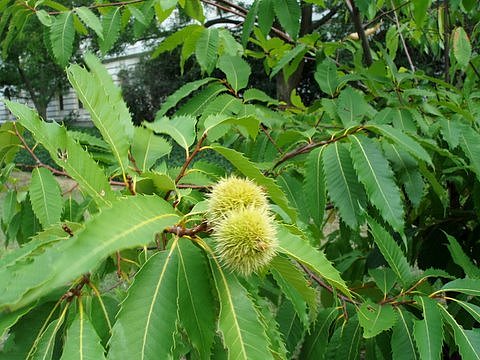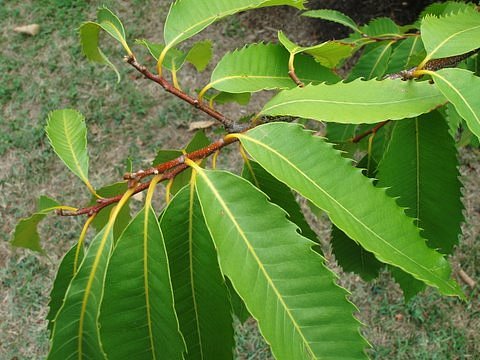
American Chestnut is monoecious, producing both male (staminate) and female (pistillate) flowers on the same tree. The male flowers are produced in long slender catkins about 4-10" long that are ascending to widely spreading. These flowers are organized into interrupted clusters along the length of each catkin. Each whitish male flower (about 5 mm. in length) consists of a calyx with 6 lobes and several exerted stamens. About 1-3 clusters of female flowers occur at the base of shorter catkins (4-6" long) near the tips of twigs, or they occur as individual clusters on short spur twigs. Each cluster of female flowers is embedded within a spiny involucre (immature husk) about 10 mm. in length; there are 2-5 female flowers per involucre. Each female flower consists of a calyx with 6 lobes and a pistil with a slender style. The blooming period occurs from early to mid-summer for about 2 weeks; cross-pollination occurs by either wind or insect activity. Afterwards, fertile female flowers develop into nuts that are surrounded by spiny husks spanning 2-2½" across. Each husk contains 1-3 nuts (rarely 4-5 nuts), dividing into 4 parts during the autumn to release them. Mature nuts are about ¾" long, dark brown or reddish brown, and globoid-ovoid in shape with slender beaks. Often, 1-2 sides of each nut are flattened by the proximity of adjacent nuts. The meaty interior of each nut is mild and sweet. The root system consists of a deep taproot.
Cultivation: The preference is full or partial sun, mesic to dry conditions, and a somewhat acidic soil containing loam, clay, or rocky material. This tree rarely achieves its full size because it eventually succumbs to chestnut blight, dying back to its root system, from which it resprouts. Because American Chestnut is self-incompatible, two or more trees should be planted in the same area. Unfortunately, because of the aforementioned disease, flowers and nuts are uncommonly produced. There are efforts under way at various foundations and government agencies to develop more disease-resistant strains of this tree.
Range & Habitat: American Chestnut is a rare tree in Illinois, where it is state-listed as 'endangered.' A large colony of this tree was discovered in Pulaski County growing on clay hills during the 19th century. This colony is now extirpated. However, specimens of this tree (up to 40' tall) have been found in other areas of the state, where they were probably introduced. Illinois lies along the northwestern range limit of this species. Prior to 1930, American Chestnut was one of the dominant trees of the Appalachian mountains. Typical habitats include rich mesic woodlands, rocky upland woodlands, and wooded clay hills. These areas are dominated by either deciduous trees or a mixture of deciduous and coniferous trees.
Faunal Associations: The flowers of American Chestnut are visited by beetles and possibly other insects; Lovell (1915) observed a beetle on the flowers, Isomira sericea, where it presumably fed on pollen and/or nectar. Other insects feed destructively on American Chestnut by boring through the wood, feeding on the foliage, sucking plant juices, etc. This latter group of insects include the larvae of a long-horned beetle, Agrilus bilineatus (Two-lined Chestnut Borer), and other beetles, the larvae of a gall midge, Macrodiplosis castaneae (Chestnut Midge), several species of aphids and armored scale insects, the treehopper Atymna castaneae, and a phylloxerid insect, Phylloxera castaneae. Several species of Lepidoptera feed on this tree, which includes the larvae of the butterfly, Satyrium caryaevorum (Hickory Hairstreak), the leaf-mining larvae of two midget moths, Nepticula latifasciella and Stigmella castaneaefoliella, and the larvae of a tortricid moth, Pseudexentera faracana (American Chestnut Leafroller); see Marshall (2006), Hottes & Frison (1931), Pepper (1965), ScaleNet (accessed 2014), Funkhouser (1917), Opler & Krizek (1984), Needham et al. (1928), and Miller (1987). Among vertebrate animals, the Ruffed Grouse and probably other birds feed on the nuts, as does the Eastern Chipmunk, while the White-tailed Deer browses on the twigs and foliage (Bennetts, 1900; Martin et al, 1951/1961; DeGraaf, 2002).
Photographic Location: The photographs were taken in Washington, D.C. by Paul Showers (Copyright © 2011).

Comments: It is highly unfortunate that this magnificent tree is barely managing to survive as the result of an introduced disease. At one time, roasted chestnuts were widely sold in cities of eastern North America as an edible treat. The rot-resistant wood was widely used to make furniture, interior finishing, fence posts, rail ties, utility poles, and paper. American Chestnut is the only species of its genus that is native to Illinois. Other North American chestnut trees (Castanea spp.) are smaller trees that are found primarily in the Ozark mountains and southeastern United States. Some Eurasian chestnut trees are occasionally cultivated in Illinois. These species include Castanea mollissima (Chinese Chestnut) and Castanea sativa (European Chestnut). Compared to the American Chestnut, the Chinese Chestnut is a smaller tree with pubescent twigs and leaf undersides, while the European Chestnut has leaves with longer petioles (exceeding 1" in length). Like many other trees, American Chestnut is associated with various fungi. An ectomycorrhizal fungus, Gyroporus castaneus (Chestnut Bolete), forms a symbiotic association with the root system of American Chestnut. The mushroom-like fruiting body of this fungus is reportedly edible. Two bracket fungi, Fistulina hepatica (Beefsteak Fungus) and Ganoderma lucidum (Lacquered Bracket), develop on standing or fallen trunks of this tree.